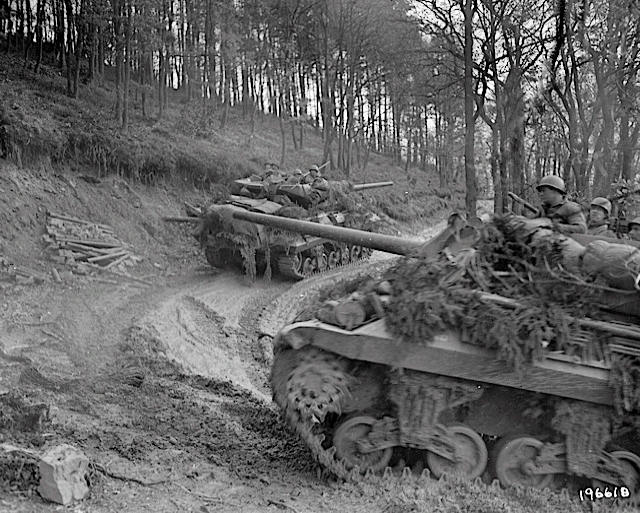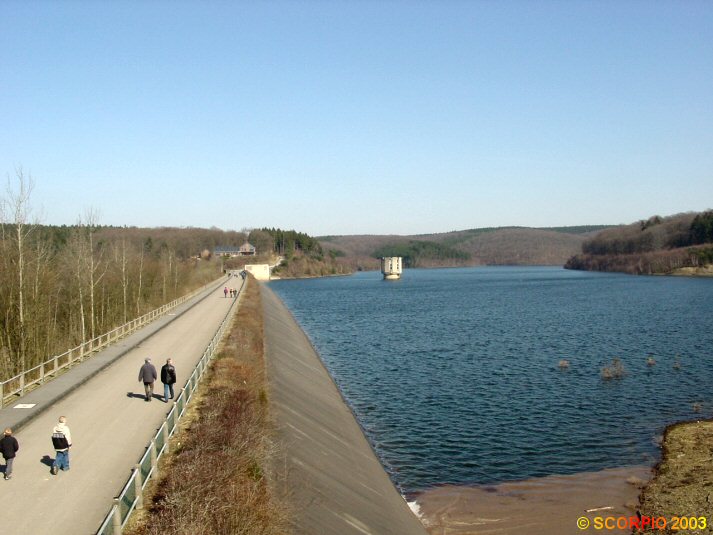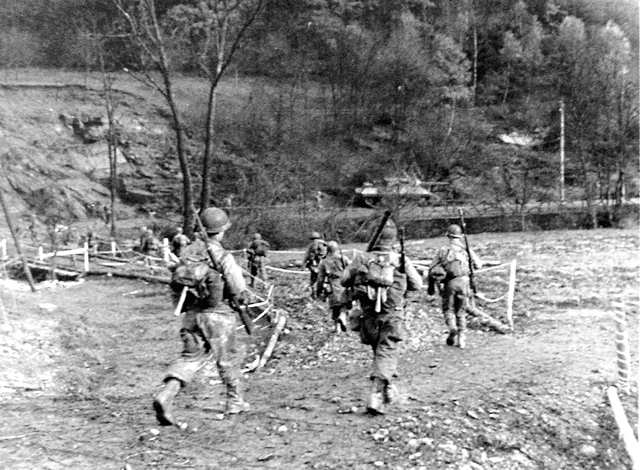4TH INFANTRY DIVISION
FOR THE PERIOD 16 NOV. 1944 - 7 DEC. 1944

18 November 1944
The 4th Infantry Division continued its attack to the east and northeast and the Regimental Combat Team had succeeded in advancing more than 1,000 meters over densely wooded terrain by nightfall.

M10's of the 803rd Tank Destroyer Battalion
twisting and turning on the slopes southeast of Schevenhütte.
November 18, 1944.
The 8th Infantry, with Company A, 4th Medical Battalion; one Platoon, Company A, 4th Engineer Combat Battalion; Company D, less one Platoon, one Platoon of Company A and Assault Gun Platoon of the 70th Tank Battalion, and one Platoon, Company A, 803d Tank Destroyer Battalion (SP), attached; the 1st Battalion crossed its line of departure, at 0915 with Company C supported by one platoon of medium tanks in the assault. The tanks led the way and ran down the concertina wire, destroying antipersonnel mines, and the attacking troops followed in the tanks' tracks without casualties to the main road in the vicinity of F-025418. Being unable to continue across the road due to steep banks, the tanks were then brought under enemy fire. The attacking infantry, however, continued, its attack under cover of tank fire until they reached the vicinity of F-029416 where they were ordered to consolidate positions for the night and effected contact with Company B coming up from the rear. During this attack of the 1st Battalion, the 2d Battalion continued its reorganization without advancing, and the 3d Battalion staged Companies I and K forward to the high ground in the vicinity of F-010416 by the close of the period.

Note from the webmaster:
By clicking the map references, the location will show up in Google Maps.
Please take notice that the Wehebach Reservoir is post war!
The 12th Infantry with Company B, 4th Medical Battalion; one Platoon, Company B, 4th Engineer Combat Battalion; Company B, 70th Tank Battalion; Company B, less one Platoon, 803d Tank Destroyer Battalion (SP), and one Platoon, Company C, 87th Chemical Battalion, attached; the 2d Battalion moved out at 0830 and passed through the line held by elements of the 1st Battalion at 1051. The advance was continued slowly by Company G for another hour and, although no contact with enemy had as yet occurred, difficulties were experienced in negotiating the many mine fields encountered. As the advance progressed, the attacking troops were held up by mines and booby traps more than from the artillery, mortar, machine gun and small arms fire that increased, throughout the day. These mine fields were encountered along the entire front and consisted mostly of teller and box mines in the roadways, S and Schu mines in the wooded areas. Companies E and F encountered small arms and machine gun fire shortly after 1600 and were unable to bring up tank support because of the nature of the terrain. At 1607, Company C effected contact with Company G while the advance of Companies E and F was stopped by the hostile fires. The positions held at this time were then consolidated, the most considerable advance having been made by Company G which had succeeded in cleaning up the area between Companies F and C.

Pfc. Maurice Benzon, S.Sgt. Bernard Spurr, S.Sgt. Harold Lessler, 8th Inf.Reg.
Northeast of Schevenhütte, November 18, 1944.
The 22d Infantry with Company C, 4th Medical Battalion; one platoon, Company C, 4th Engineer Combat Battalion; Company C and one Platoon, Company D, 70th Tank Battalion; Company C, less one Platoon, 87th Chemical Battalion, and Company C, 803d Tank Destroyer Battalion (SP), attached, attacked at 0830 with the 1st and 2d Battalions abreast (1st Battalion on the left), across the main north-south road towards their objective (the high ground in the vicinity of F-027393). The 2d Battalion immediately encountered heavy machine gun and small arms fire and the 1st. Battalion advanced slowly against heavy mortar and artillery fire. The 2d Battalion was held up but at 1013, Companies A and C were astride the road in the vicinity of F-024385, where artillery and small arms fire was becoming intense. As the situation developed, the 3d Battalion moved to the north to protect that flank and maintain contact between the attacking battalions. By 1345, the 1st Battalion had progressed 500 yards beyond the roadway and had secured its objective. The 2d Battalion resumed its attack at 1430 and within an hour and a half, had pressed forward some 500 yards. By 1650, the battalion had come abreast of the 1st Battalion and was upon its objective.

Co. I, 3rd Bn, 8th Inf.Reg. at Lamersiefen/Joaswerk south of Schevenhütte
Serious difficulties of supply and evacuation greatly handicapped the advance of the Combat Team. The few roads in the sector, because of weather conditions, were in poor shape and were heavily mined as well as almost constantly being interdicted. Such conditions naturally resulted in the loss of important armor support.
19 November 1944
The 4th Infantry Division continued its attack but progress was extremely slow due to the increasing number of mines, continuing poor road conditions necessitating the transportation of virtually all supplies to front line units by hand, over heavily wooded terrain.
The 8th Infantry, with Company A, 4th Medical Battalion; one Platoon, Company A, 4th Engineer Combat Battalion; Company D, less one Platoon, Company A, Assault Gun Platoon, 70th Tank Battalion, and Company A, less one Platoon, 803d Tank Destroyer Battalion (SP), attached; at 0940, the 1st Battalion endeavored to initiate an attack but was unable to advance because of heavy enemy small arms, mortar and tank fire. However, the 3d Battalion began movement at 0930 in a column of companies in order I, K, and L, in the trace of the 1st Battalion until leading elements had reached the vicinity of F-027415, at which time they were brought under heavy fire. Companies K and L, while Company I dug in and defended, turned to the south to seize a limited objective. By 1700, Company K had secured this objective and captured 48 prisoners, while Company L advanced to the vicinity of F-021404 where positions were consolidated for the night.
The 12th Infantry, with Company B, 4th Medical Battalion; one Platoon, Company B, 4th Engineer Combat Battalion; Company B, 70th Tank Battalion; Company B, less one Platoon, 803d Tank Destroyer Battalion (SP), and one Platoon, Company C, 87th Chemical Battalion, attached; an attack was initiated by the 2d Battalion at 0845. Continuous mortar fire was received during the day in the 2d and 3d Battalion sectors. This fire was heavy and accurate enough to make mine removal and work on the necessary stream crossings a slow and tedious process for both the infantry and the supporting engineers. Interlocking bands of heavy machine gun fire were sighted covering the continuous mine fields which the enemy had laboriously installed in every firebreak. Numerous efforts made in various elements of the Combat Team to advance throughout the day resulted in Company F advancing a short distance and reaching a point abreast of Company G. Little other gains were reported during the day.
The 22d Infantry, with Company C, 4th Medical Battalion; one Platoon, Company C, 4th Engineer Combat Battalion; Company C, and one platoon, Company D, 70th Tank Battalion; Company C, less one Platoon, 87th Chemical Battalion, and Company C, 803 Tank Destroyer Battalion (SP) attached; supply routes to the leading battalions had not yet been opened and the 2d Battalion was not resupplied by the morning of the 19th, which necessitated postponement of the operation planned for this date. During the morning, hand carrying parties were organized from Service Company to resupply the 2d Battalion and throughout the day continuous progress was made in clearing forward routes for motor traffic. Positions were consolidated and patrols operated to the north and east, several skirmishes occurred and prisoners were taken.
At 1545, a by-passed enemy strong point opened fire on the Regimental CP's outposts with small arms and mortar fire. Company K was alerted to reinforce the CP security and was in position by 1830. Enemy mortar and artillery fire fell continuously on front line elements during the entire period.

